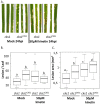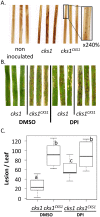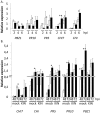Cytokinin Production by the Rice Blast Fungus Is a Pivotal Requirement for Full Virulence
- PMID: 26900703
- PMCID: PMC4765853
- DOI: 10.1371/journal.ppat.1005457
Cytokinin Production by the Rice Blast Fungus Is a Pivotal Requirement for Full Virulence
Abstract
Plants produce cytokinin (CK) hormones for controlling key developmental processes like source/sink distribution, cell division or programmed cell-death. Some plant pathogens have been shown to produce CKs but the function of this mimicry production by non-tumor inducing pathogens, has yet to be established. Here we identify a gene required for CK biosynthesis, CKS1, in the rice blast fungus Magnaporthe oryzae. The fungal-secreted CKs are likely perceived by the plant during infection since the transcriptional regulation of rice CK-responsive genes is altered in plants infected by the mutants in which CKS1 gene was deleted. Although cks1 mutants showed normal in vitro growth and development, they were severely affected for in planta growth and virulence. Moreover, we showed that the cks1 mutant triggered enhanced induction of plant defenses as manifested by an elevated oxidative burst and expression of defense-related markers. In addition, the contents of sugars and key amino acids for fungal growth were altered in and around the infection site by the cks1 mutant in a different manner than by the control strain. These results suggest that fungal-derived CKs are key effectors required for dampening host defenses and affecting sugar and amino acid distribution in and around the infection site.
Conflict of interest statement
The authors have declared that no competing interests exist.
Figures








References
-
- Kamoun S. (2007) Groovy times: filamentous pathogen effectors revealed. Curr. Opin. Plant Biol. 10, 358–365 - PubMed
-
- Verdier V. et al. (2012) Transcription activator-like (TAL) effectors targeting OsSWEET genes enhance virulence on diverse rice (Oryza sativa) varieties when expressed individually in a TAL effector-deficient strain of Xanthomonas oryzae. New Phytol. 196, 1197–1207 10.1111/j.1469-8137.2012.04367.x - DOI - PubMed
Publication types
MeSH terms
Substances
LinkOut - more resources
Full Text Sources
Other Literature Sources
Research Materials

